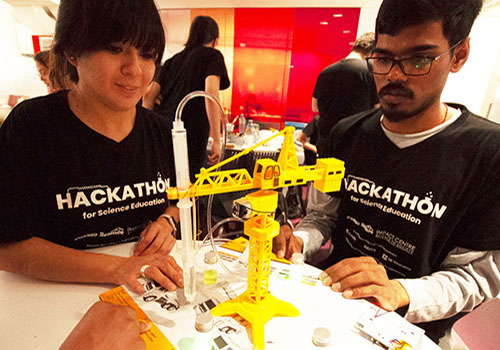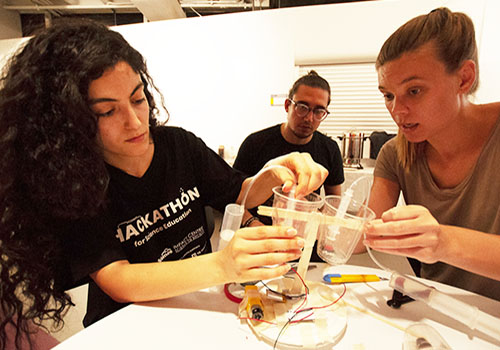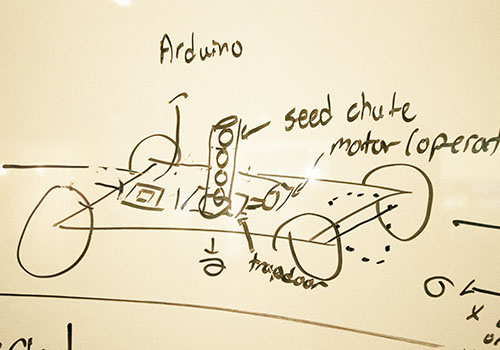For two days in late September, 50 students, postdoctoral fellows or recent graduates of the University of Toronto or other Canadian post-secondary schools came together to combine robotics, coding and science education to hack a better world.
They were participating in the inaugural Hackathon for Science Education organized by the Faculty of Arts & Science’s Impact Centre and Pueblo Science.
“The Hackathon for Science challenged participants to develop a hands-on activity for teachers that uses robotics to explain a scientific or engineering concept to their students,” says Leo Mui, the Impact Centre’s manager of entrepreneurship initiatives and the lead organizer of the event.
“The activity needed to be easy for teachers to set up, low cost — and it had to be something that could be completed in two or three 90-minute classes.”
In addition, the projects needed to give students a positive STEM (science, technology, engineering and math) learning experience, help develop their problem-solving skills and fulfill the Impact Centre’s mission.
“Our mission is ‘science to society’ and the hackathon is just one way in which U of T science expertise can be used to benefit society,” says Mui.
Participants arrived at the hackathon on Saturday morning and — with little prior instruction or knowledge — learned the details of their challenge.

They also heard from Anyin Choo, Guyana’s consul general to Toronto. The Impact Centre and Pueblo Science — an organization founded in 2010 to advance science education — have developed a relationship with the South American country through a variety of initiatives and the hackathon was an opportunity for participants to develop projects with that country in mind.
“Our Ministry of Education has formed partnerships with a number of foreign NGOs — including the Impact Centre and Pueblo Science — to implement programs in schools aimed at teaching STEM and robotics across schools in Guyana,” says Choo.
Teams had three hours to brainstorm and develop their concepts after which they went shopping for supplies — which included everything from toy construction kits to electronic components.
After that, fabrication and coding began and by Sunday afternoon, teams were ready to present their work to a panel of judges.
Riley Hickman is a graduate student in the Faculty of Arts & Science’s Department of Chemistry. He and his Atoms Family teammates devised a game that combined robotics and chemistry. The game was played with a computer-controlled, crane-like device that mixed two solutions to create a chemical reaction called titration.

“The object is to be the first player to successfully titrate the contents of a vial,” explains Hickman. “We came up with the concept as a way to introduce students to the benefits of robotic experimentation and to teach some essential concepts about acid-base chemistry.”
Kevin Ge is a member of New College and an undergraduate studying computer science. He and his CS Yutes teammates built a small robotic rover they dubbed Robo-Dropper. It was inspired by Choo’s description of agriculture in Guyana and, as the name suggests, was designed to drop seeds into the ground at regular intervals.
“Our goal was to get students interested in computer science by showing them the power of automating tasks through programming,” explains Ge. “To us, this concept was more important than the technical details of building a robot or the math behind calculating distances.”
Other projects included a boat that automatically detects oil spills, a robo-illustrator, a mechanical arm that demonstrates how nerves work and a robotic oil pump.
In the end, the judges deemed six teams worthy of the prize money — including the Atoms Family and CS Yutes — instead of five as originally planned.

“The projects were interesting and fun and in most cases quite applicable to Guyana,” says Choo. “I was very impressed with the level of maturity, team work and enthusiasm displayed by the students. In my books, they are all winners and I believe the future of our world is in good hands.”
In keeping with the centre’s mission, the hackathon participants — even after 20 hours of intensive coding and soldering — left the event with a global perspective.
“The hackathon was an excellent opportunity for students to exercise their scientific creativity, and their software and hardware skills,” says Scott Browning, an associate professor in the Department of Chemistry and another Hackathon judge. “But the best thing about the event was its purpose — to create meaningful, hands-on learning activities in science for high school students in disadvantaged communities in Canada and around the world.”
“I’ve gained a new sense of altruism,” say Ge. “Instead of seeing technology as a way to build first-world consumer products, I’m beginning to see how technology can solve problems faced by people in developing countries.”
“It felt very exciting to know that our project could potentially ignite a lifelong passion for science in students around world,” says Hickman. “The world needs more scientists.”
Additional support for the Hackathon was provided by the U of T Pillar Sponsorship Program and by Manulife, MBNA and TD Insurance.
This article was originally published at the Faculty of Arts & Science website.


